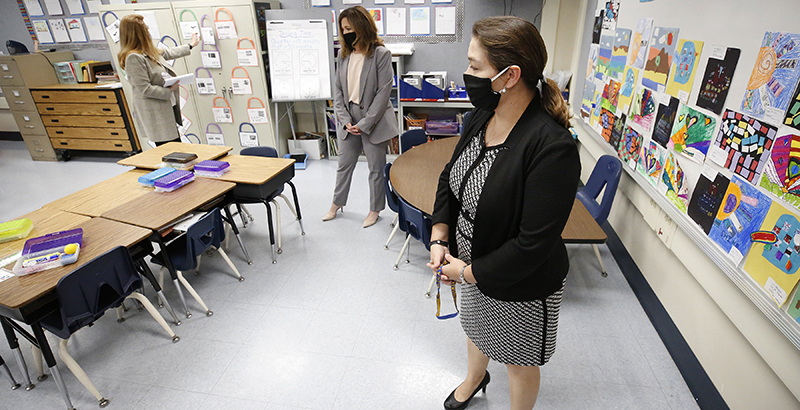Coronavirus Must-Reads for Parents & Schools: 94% of Superintendents Uncertain on Fall Classes, Health Concerns May Keep Teachers Away, Safety at Reopened Playgrounds & More

This is a special edition of EduClips, our recurring roundup of top education headlines from America’s 15 largest school districts, where more than 4 million students across 10 states typically attend class every day. See our full EduClips archive right here.
If you look up “First Day of School” on Wikipedia, you’ll be greeted with the following bit of conventional wisdom: “This is usually in August or September in the Northern Hemisphere.” That factoid is only one part of what has become a daunting equation for schools, districts and states as they stare down the enormous question of when (and whether) to reopen schools in the fall. A recent survey by the AASA, the national school superintendents association, reveals the second part. In the June 16 survey, the association said that 94 percent of superintendents said they weren’t ready to announce whether they’ll reopen or resume in-person instruction. Even with the necessary caveats — the poll was conducted between May and June, when reopening for the 2019-20 school year was still a possibility — the math is straightforward: Officials have mere weeks to make what will undoubtedly be the most important decision of their careers.
The stakes? “You don’t want to be the superintendent to open too quickly and somebody dies,” Kristi Wilson, superintendent of the Phoenix-area Buckeye Elementary School District, where schools reopen Aug. 5, bluntly told Politico. “Live with that! It’s just way too much to take on.” But the penalties for remaining closed are also severe. Experts recently announced that the economy entered a recession in February. No recovery can happen unless parents return to work, and that can’t happen if kids don’t return to school.
The bits and pieces of reopening plans that have already come to light only underscore the uncertainty. New York City, the nation’s largest school system, indicated that 20 percent of its teachers might have to work from home due to health concerns. As Chalkbeat noted, those 15,000 teachers represent more teachers than Houston’s entire public school system. And elsewhere, there has been considerable pushback. In Massachusetts, the governor’s plan to make children come to school with their own masks has come under fire for punishing low-income students and minorities. And in New Jersey, several district chiefs called the state’s guidelines for in-person summer programs “inappropriate.”
A large part of the problem is that districts have to foot the hefty price tag for new health and safety protocols at a time when they are already hemorrhaging from the recession. The AASA estimates that it will cost an average school district with 3,700 students $1.8 million to meet reopening guidelines set by the Centers for Disease Control and Prevention, including $448,000 for additional custodial staff. “I mean, it’s like it’s a lose-lose situation,” said Dan Domenech, who runs the AASA. “You have parents that are demanding the schools to open. And then you have parents that are saying, we’re not going to send our kids to school. You have teachers that are saying, we’re not going to go back to work. Districts that are saying, with these budget cuts, we’re going to have to lay off teachers. … It’s just, this is unbelievable.”
Top Stories
Equity — Pandemic High: How One of Chicago’s Largest Schools Rebuilt Itself for Cyberspace (Read at Chalkbeat)
Reopening Schools — The Socially Distanced School Day (Read at Education Week)
Black Lives Matter — High School Students and Alumni Are Using Social Media to Expose Racism (Read at The New York Times)
Immigration — A Border School for Asylum Seekers Goes Virtual (Read at The74Million.org)
Teachers — As Teacher Layoffs Loom, Should Schools Seek Private Donations? (Read at WGBH)
Parents
As COVID-19 Threatens Millions of Child Care ‘Slots,’ Families Face Deep Disruptions to Their Children’s Early Learning and Social Development and to Their Own Jobs (Read at The74Million.org)
‘Our Kids Had Been Forgotten’: Parents of Special Education Kids Hope for Summer School (Read at USA Today)
As Playgrounds Start to Reopen, Here’s How to Keep Kids Safe (Read at The New York Times)
Hundreds of Southern California Schools Vulnerable to Outbreaks Because of Vaccine Reluctance, Data Suggests (Read at The Mercury News)
Educators
20% of NYC Teachers Might Work From Home Because of Health Concerns, According to Education Department Estimates (Read at Chalkbeat New York)
A Teacher Ponders Risk of Returning to Work While Being Paid Less Than Unemployment (Read at NPR)
Teachers Need Opportunities to Heal Before the School Year Begins (Read at EdSource)
Pandemic Fallout
Could the Online, For-Profit College Industry be “A Winner in This Crisis”? (Read at The Hechinger Report)
Analysis: Just 1 in 3 Districts Required Teachers to Deliver Instruction This Spring. They Mustn’t Be Left on Their Own Again in the Fall (Read at The74Million.org)
Colleges Are Ditching Required Admission Tests Over COVID-19. Will They Ever Go Back? (Read at The Washington Post)
Charter Schools, Some With Billionaire Benefactors, Tap Coronavirus Relief (Read at The New York Times)
5 Radical Schooling Ideas for an Uncertain Fall, and Beyond (Read at NPR)
Meanwhile, Beyond the Pandemic…
DACA Teachers Across the Country Embrace SCOTUS Ruling Allowing Them to ‘Live, Work Without Fear’ (Read at The74Million.org)
The End of Police in Schools (Read at U.S. New & World Report)
A Black Teacher Questioned Eva Moskowitz’s Response to George Floyd’s Death. Now, Success Academy Is Facing Bigger Questions About Race (Read at Chalkbeat NY)
‘The Students Were the Danger’: In Racially Diverse Schools, Police Were More Likely to View Students as Threats, Study Shows (Read at The74Million.org)
Essays and Reflections
Bradford: Black Lives Matter and Black Education Matters Because Freedom Matters. Only When Black Folks Are Safe to Both Learn and Live Will America Be Free (Read at The74Million.org)
Analysis: For Foster Children in Texas, a State of Despair (Read at The Texas Tribune)
How the New York City School System Failed the Test of COVID-19 (Read at The Nation)
Fuck the Bread. The Bread Is Over. (Read at The Paris Review)
In the Face of American ‘Truth Decay,’ Polls Shed Light on How Much Families Are Hurting During COVID-19 (Read at The74Million.org)
QuotED
“I was able to drive, live, work without fear. Without the constant fear that I’m going to get deported at any minute.” —Karen Reyes, an Austin, Texas, bilingual special education teacher, after the Supreme Court handed down its decision blocking the Trump administration’s effort to end DACA, the program that’s allowed some 650,000 immigrants who were brought into the U.S. as children — as Reyes was — to live and work without the threat of deportation. (Read at The74Million.org)
“You don’t want to be the superintendent to open too quickly and somebody dies. Live with that! It’s just way too much to take on.” —Kristi Wilson, superintendent of the Phoenix-area Buckeye Elementary School District, where schools reopen Aug. 5. (Read at Politico)
“At a time when our kids and our communities need us most, we are having to make massive cuts. We must double down for those who have been most impacted by the COVID crisis if we are to deliver on the promise of education to create a more equitable society.” —Susana Cordova, the superintendent of Denver Public Schools. (Read at The New York Times)
“This is my great worry. In a moment when we should be investing, we are going to be seeing cuts because Congress apparently feels no urgency … as schools are trying to get ready for what is arguably the most important beginning of a school year that will happen in a lifetime.” —Minnesota Sen. Tina Smith, a Democrat. (Read at Education Week)
“The concerns that the [school police] had by and large were about the students themselves. It wasn’t about protecting these innocent [youth] from dangers that could come from the outside — the students were the danger.” —Ben Fisher, an assistant professor of criminal justice at the University of Louisville, on research showing enormous gaps in how school police viewed threats at racially diverse and predominantly white schools. (Read at The74Million.org)
“Remote learning may be able to crack into students’ minds, but I think the pain of this reality is knowing that remotely reaching students’ hearts is not the same.” —Allison Tingwall, principal of Curie Metropolitan High School in Chicago. (Read at Chalkbeat)
Get stories like these delivered straight to your inbox. Sign up for The 74 Newsletter

;)
